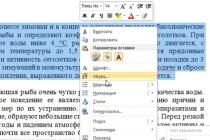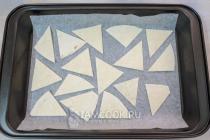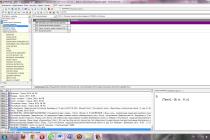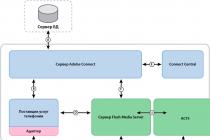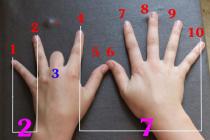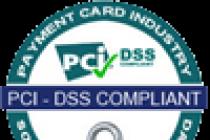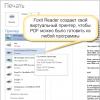It may sound sad, but sticks of RAM, called RAM, or, in the English version, RAM, can cause a huge number of problems, starting with the usual delay in loading the operating system and ending with its complete crash (especially if the most primitive conditions are not met, which you need to pay attention to). In general, a test of RAM (take Windows 7 64 bit as an example) will have to be performed when installing new modules or replacing old ones. And at the same time, it is worth taking into account several main factors, which in the future can affect the identification of the causes of malfunctions or the appearance of conflicts.
Why do I need a Windows 7 64 bit RAM test?
First of all, you need to clearly understand that not every RAM module can fit into the slot motherboard and work without problems. The "motherboard" itself may simply not support the installation of some types of brackets or even similar equipment from unknown manufacturers (although it may meet all the stated criteria).
The question is different: most users try to test RAM only when too obvious problems are found in the computer. And when checking equipment, most of us completely ignore parameters such as clock operating frequency, timing, operating voltage, supported bus, bandwidth (which, by the way, must be compatible with the processor one), etc.
Preliminary equipment check
And when problems arise, which are most often expressed in the fact that when the operating system starts up, error messages begin to appear (most often this blue screen with an error code indicating that the failure occurred not in software, but at the physical level) everyone tries to reboot the system, considering the error to be a temporary short-term phenomenon. This is not true.

Thus, the RAM test (Windows 7 64 bit in our case) should initially be limited to checking the physical state of the motherboard slots, the operability of the RAM strips and the correspondence of the equipment characteristics to each other.
For starters, really try just restarting your computer terminal or laptop. Sometimes (with too much RAM load) the system freezes because of this. It means that there are too many applications and system processes running at the moment, which take up the maximum amount of RAM, and additional virtual memory, for which the pagefile.sys file is responsible, which reserves free space on the system and logical drives, is also missing.

A little distracted, it is worth saying that even if there is logical partitions a swap file is created for each of them.
The easiest method to check for blue screens on desktop PCs
Now let's turn to stationary computers, since they check the performance of any bar in a completely elementary way. At least the suggested test of Windows 7 64 bit RAM - or any other system - will give a result immediately. The bottom line is to first remove all RAM modules from their respective slots while the computer is off, and then insert them one at a time, followed by a reboot. If the system starts up in an operational mode, there are no memory problems. Otherwise, the bar itself will have to be replaced either due to a breakdown or due to a mismatch with the parameters of the mother chip.
Are there any built-in system facilities?
The Windows 7 64 bit RAM test, if anyone does not know, is initially turned on at the start of the computer itself. In other words, when voltage is applied to the motherboard, the primary system for determining "hardware" devices BIOS or its more modern version of UEFI, which has a graphical interface, comes into play. That's not the point. Ever notice that the stationary unit, when turned on, sends a signal from the system speaker? A short one-shot signal is exactly what corresponds to the fact that all system components are in order.

If something goes wrong, you should enter the settings of the primary I / O system and check the RAM parameters (in particular, this concerns the voltage supplied to the strips, the bridge used, etc. - overlockers understand what this is about).
How do I use the built-in diagnostics?
But self-diagnostics in the BIOS is far from the most ideal way to determine the full operability of the "RAM". An error test of Windows 7 64 bit RAM by itself can cause incorrect data to appear in reports. The problem is that both BIOS and Windows can perceive RAM completely differently.

Here you will have to use at least the built-in system tool. First, you need to call the "Start" menu and write the line mdsched in it, after which the application that appears will offer to use two options for checking: without restarting and at the next start. It is better to choose the second method, despite the recommendations of the system. It will take a little longer during reboot, but problems will be identified for sure.
Windows 7 64 bit RAM test: Memtest86 + program and AIDA64 application
But the tools of Windows systems quite often lose to third-party software... The Mentest86 + utility is recognized as one of the most powerful programs.

Its only drawback is that it only works in DOS mode and gives exactly errors of access to RAM sectors by the type of scanning. hard drives... An ordinary user will understand little about this, but the error addresses can tell a lot to an advanced user.

The second utility (in Russian) tests Windows 7 64 bit RAM in such a way that even at startup it gives out the main characteristics of the motherboard and compatible RAM modules. If you use the SPD section, you can learn a lot of interesting things about your "motherboard" and RAM strips. For example, it will clearly indicate what the maximum volume is supported, which manufacturer is suitable, which slots with their electrical parameters can be used, etc. In general, it is generally accepted (among users, among experts) a test of Windows 7 64 bit RAM program "AIDA" produces the best (although none of the proposed utilities fixes the problems, as far as diagnostics are concerned). But that's not all.
RAM check from USB stick
Even if there are problems with the hard drive, memory or PC startup, the Windows 7 64 bit RAM test (errors will only be detected, but not corrected) can be performed even when booting from removable media, for example, a regular USB flash drive.
The most important condition is to download not only the Memttest86 + utility, but also its additional installer, but not in the form of an ISO image, but in the form of a special USB installer, from which you will need to create bootable USB drive... After that, when you reboot the system, you first have to enter the BIOS settings and set the USB device used as the first one when starting the computer, then boot and perform the appropriate test.
Recording and using an optical disc
If someone does not like this option (for example, a person is accustomed to using exclusively CD / DVD discs, or the settings of the primary system in terms of perception of the first device from an optical medium look simpler), you can use the same utility Memtest86 +, launched exclusively in compatibility mode with Windows (not DOS), after which, when specifying the medium to which the main package and boot data will be written, the corresponding drive is selected in the menu.
Possible problems
Sometimes you can notice that when loading the above utility from removable media, users often note that the check goes quickly enough at first, but at some stage it just hangs. In principle, as the developers themselves note, this is normal. The point is that testing is done according to the principle of several passes. In this case, one or two is enough. If there are RAM errors, they will be detected immediately. If they are not there, when the utility hangs, the testing process can be terminated forcibly.
Conclusion
As you can see, this is exactly what the Windows 7 64 bit RAM test looks like. Which program can be used? The question is quite complicated, because none of the currently created utilities can fix errors and the problem (in contrast to the same testing programs, error correction, or even remagnetization of the surface of hard drives). Alas, if problems are detected, you will have to change the memory strips, since they can cause physical damage to the hardware and provoke the appearance of hardware conflicts even at the software level of the primary BIOS / UEFI systems, not to mention the main components of Windows, which have attitude only in plan system requirements and the maximum available volume for downloadable software modules in the form of heavyweight dynamic libraries, which for serious software products in the main set are mandatory.
For none of the users, perhaps, it will not be the discovery of the century that most of the error messages that appear when working with Windows 7 arise due to all kinds of problems with the computer's RAM. At the same time, finding them is not so difficult as it seems at first glance, and even without resorting to help extraneous programs... The point, in fact, is that in the Windows 7 operating system itself there is already a built-in utility for checking the RAM, which, in terms of efficiency, is not much inferior to similar programs-analogues. Want to check it out? Then get down to business!
Option # 1: Microsoft's System Method
It is worth noting that testing RAM using Windows 7 itself can be performed in different ways, depending on whether the computer is in working order or not. In particular, for a routine check of the operability of RAM on a PC, you can use the following method:

In addition, it is possible to check the operation of the RAM at the start of Windows 7. In this case, when starting the computer, you will first need to press F8 in order to get to the menu of additional boot options, and then alternately select Esc on the keyboard (to access the manager download windows), Tab (to select a memory test tool) and finally Enter (to start diagnostics): 
At the same time, you can arrange a RAM test using a disk with Windows distribution 7. In this case, after starting it on the computer in the Windows installation mode, we only need to open the system recovery options and select the memory diagnostic program among them. The whole process looks like this: 
In any case, regardless of the selected method, after the start of the system diagnostics of the RAM, a blue window will appear in which the entire check progress will be displayed:

True, it should be borne in mind that by default in Windows 7, the usual set of several is selected. standard tests RAM. It provides, of course, a fairly prompt in time, but average in efficiency check: 
In this case, for a more thorough analysis of the RAM after launching the utility, it is preferable to reconfigure the test scheme by choosing a wide set instead of the usual set. How to do it? Just press F1 first and then Tab to select the appropriate parameter and F10 to save the setting. Similarly, you need to disable the cache check and increase the number of passes to at least 20 in order to increase the efficiency of the test.
One way or another, after the RAM analysis is completed, the testing tool built into Windows will notify about all errors found in the report or in the system message after restarting the PC (depending on the selected diagnostic method).
Option number 2: RAM tester programs
In the same time RAM on a computer with Windows 7, you can check for errors using special RAM tester programs. They are widely presented today, but free software such as SuperRam, MemTest86 and SiSoftware Sandra deserve special attention among them.
The easiest to use among them is undoubtedly the Russian-language SuperRam utility. At the same time, in terms of the efficiency of RAM tests, it differs little from the well-known software "monster" MemTest86. This utility, in particular, allows not only to test the RAM on the computer in different modes, but also automatically increases the productivity of its use. In addition, the program is compatible with absolutely all RAM modules and Windows versions making it a truly indispensable PC tester. 
Meanwhile, at the first signs of the impending demise of RAM, appearing along with the blue screen of death, the MemTest86 program can bring the computer back to life. Its peculiarity is that, unlike many other similar utilities, it is launched in a "pure" form using its own loader, which provides it with a more thorough test of the operating memory for bugs. 
True, MemTest86 has two small drawbacks. Firstly, in order to check the RAM with it, you will first have to do some work on recording a resuscitation flash drive with an iso-image of the utility; and, secondly, the process of analysis with the help of this tester software tool usually takes a lot of time - from 1 hour or more, as practice shows. 
As for SiSoftware Sandra, this program can hardly be called a full-fledged RAM tester, given that it also has a general Windows stability test and separate modules for analyzing the state of the motherboard, CPU, video card and other equipment connected to the PC. Meanwhile, its performance indicators are quite good, which, however, distinguishes it from a dozen other analogue programs.
I am glad to welcome you to the site! In this article I will tell you everything about diagnosing the RAM of a computer / laptop.
Let's talk about the symptoms indicating that there may be some errors in the "RAM", as well as how to check it for operability and "integrity".
So, let's begin!
Random access memory, or RAM (random access memory) is the "temporary" memory of a computer. This is the so-called "buffer" between hard disk, which permanently stores your programs and data, and the processor that processes this data. This memory is volatile, i.e. it resets to zero each time the computer is restarted or powered off.
RAM is a small bar that fits into the motherboard connector. Like any component of a computer, this bar can fail.
In general, all these symptoms do not necessarily indicate a malfunction of the RAM strips. Hangs and errors when Windows installation more often due to hard disk, BSODs - due to OS errors, viruses. It is possible to say for sure whether there are broken blocks or errors in the RAM only by conducting memory tests using the methods that I will describe to you below.
If you better perceive information in video format, you can watch a video clip on my YouTube channel:
How to check the RAM [Video]
How to check the RAM of your computer
The easiest way to check RAM is the exclusion method. Most often, the computer has 2-4 RAM modules. Therefore, you can take them out in turn, and check if the problem is gone. If, without one of the memory modules, freezes have stopped and errors have disappeared, then it is faulty.
But, it is quite possible that you have one memory module.
To find and remove the RAM from your system unit- take a close look at the picture below. I think everything will immediately become clear to you. You need to bend the latches on the sides of the memory - and it will "pop out" by itself. 
And here is how the RAM looks and is removed from laptops:

Checking RAM for errors using Windows
If your system boots normally, but it produces various failures and errors in operation, then you can use standard means Windows to check RAM.
It is called that - " Diagnosing problems with computer RAM.»
This facility is built into the operating room. Windows system 7 and Vista, and we just have to find and use it:
- Push the button Start, and in the field “ Find programs and files»Enter the part of the name of the program that we need to find. I entered "operative". Among the list of programs we find “ Diagnostics of problems of computer RAM ":

- In the window that appears, you can choose when the check will be performed - right now or the next time you turn on the computer:

We close all open programs, save the documents, and run the first item to restart the PC and start checking the RAM right now. - After reboot will automatically start and start checking the memory. We are waiting while the check is being performed, you do not need to touch anything.

On my configuration (i5-4460, 16 Gb DDR3), testing in normal mode took about 15-20 minutes.
By pressing the F1 key, you can select other test options (Basic and Wide), as well as the number of passes. Optionally, you can check with Wide a set of tests, but it will take several times longer, so first do Normal test.
- After the test completes, Windows will continue to boot.
- To view the result of the Windows RAM test, you need to go to Event Viewer -> Windows Logs -> System -> MemoryDiagnostics-Results:

Memory tester - memtest86 +
It is best to use special program — memtest86 +.
Its advantage is that it can be used even if Windows does not boot, or there is no hard disk in the PC at all.
Download the program for checking RAM you can from the official website memtest.org, or right here on my blog (files checked for viruses): the memory test will start. It looks like this:

The test takes place in automatic mode, you don't need to change anything, just watch. He will go endlessly. If after 1-2 passes (Pass) no red bars with errors appear in the field below, and the "Errors" counter is equal to zero, then your memory is almost certainly clean!
Many are probably wondering what the test of a "broken" RAM looks like? To see it - watch the video below.
Memory test memtest86 + - 1.5 million errors [Video]:
By the way, subscribe to my youtube channel ... There I show the whole process of diagnostics and repair of computers and laptops in real time in video format.
»I described the tools available in the System Recovery Options menu and promised to tell you more about them in the following articles. I recently had to use the Windows Memory Diagnostic tool, so I decided to start with that.
So, if you encounter application and operating system crashes or STOP errors, the reason may be defective RAM. The Windows Memory Diagnostic Tool allows you to check RAM modules for faults. In this article, I will show you how to start and use it.
Running Windows Memory Diagnostics
You can run the Windows Memory Diagnostic Tool different ways, depending on the specific situation. As I mentioned in the previous article, it can be invoked from the System Recovery Options menu. But if operating system loads fine, and problems arise only occasionally, then everything is much simpler.
Click the Start button, open the Control Panel and click the System and Security icon. In the window that opens, select the "Administrative Tools" item and click on the "Windows Memory Diagnostics" icon. Or you can simply open the Start menu, type “memory” in the search bar, and select “Windows Memory Diagnostic” from the results.
The Windows Memory Diagnostic (Figure A) window appears. Select the Restart Now and Check for Problems option. The dialog box will close and the system will automatically reboot.
Figure A. To run memory diagnostics, select the "Reboot and check" option.
Running and checking memory
Regardless of the startup method you choose, after restarting, the Windows Memory Diagnostic screen appears and the test begins. The progress of the operation is indicated as a percentage and is indicated by a progress bar (Figure B). During the diagnostic process, the utility repeatedly writes certain values to memory, and then reads them out to make sure that the data has not changed.

Figure B. Testing begins immediately after the blue and white Windows Memory Diagnostic Tool screen appears.
By default, the Standard test is used, but two other options are available. To select one of them, press the button to open the Options screen, shown in Fig. C.

Figure C. In the Windows Memory Diagnostic options, you can select Basic or Extended test.
In the Test Mix section, you can select the Basic test, which includes a limited set of tests, or the Broad test, which offers an expanded range of tests — so advanced that a test can take eight hours or more.
Each test suite has default cache settings that are optimal for a given test case. But you can use the key to go to the "Cache" section and set your own settings. In this case, cache refers to the microprocessor's cache, which is used to store data received from memory modules. Some tests use the cache, others, on the contrary, disable it to force the processor to access memory modules directly.
Each test is run twice by default. But you can use the key to go to the "Pass Count" section and specify how many times the test should be repeated. After changing the settings, click to save the settings and start testing.
As it progresses, the Status section displays information about the detected faults. But it is not at all necessary to constantly monitor the process, since the Windows memory diagnostic tool is able to identify the problem sector of the chip and exclude it from use. This will allow Windows 7 to start normally without crashing.
After Windows boot and logging into the system, a message about the results of the scan will appear in the notification area (Fig. D).

Figure D. The report on the verification results can be viewed in the pop-up notification.
The report can also be viewed using the Event Viewer. Open the System log and find MemoryDiagnostics-Results in the Source list. The Event ID should read 1201 (Figure E).
You could also be interested in the health of your RAM out of idle curiosity, but, most likely, this interest arose by force. For example, for no reason at all, the computer issued a blue screen of death (abbreviation BSOD). Be that as it may, and it will not hurt anyone to check the operability of the RAM. Moreover, Windows 7 has built-in tools for this. By the way, such a check can be carried out immediately after purchasing a new "RAM" module - if there are problems, you can immediately replace it. RAM testing Windows utility Memory Diagnostic Before checking, it is recommended to return all settings to the "default" state in the BIOS. If you remember for sure that you did not make significant changes, such as overclocking or adjusting voltage parameters, then you can not touch anything. We press the "Start" button. In the search field, write "Windows Memory Checker" or "mdsched" (without quotes). We launch the program.  A window appears with two options for further actions. We close all programs, save the documents and choose the first option.
A window appears with two options for further actions. We close all programs, save the documents and choose the first option.  After rebooting, the diagnostic program starts automatically and its interface will be in a blue window. " Runningtestpass 1of 2"(Pass 1 of 2 is performed) - we see by what percentage the first test pass is completed. Whereas the general state of the test as a percentage - in the line below ( Overallteststatus). Below, under the line “ Status»The detected problems will be shown, if, of course, there are any. In our example, they are not.
After rebooting, the diagnostic program starts automatically and its interface will be in a blue window. " Runningtestpass 1of 2"(Pass 1 of 2 is performed) - we see by what percentage the first test pass is completed. Whereas the general state of the test as a percentage - in the line below ( Overallteststatus). Below, under the line “ Status»The detected problems will be shown, if, of course, there are any. In our example, they are not.  To change the testing parameters, click F1... A window with options appears. First point - " TestMix"(Test suite). We choose one of the points:
To change the testing parameters, click F1... A window with options appears. First point - " TestMix"(Test suite). We choose one of the points:
- « Basic»(Basic) - only three basic tests;
- « Standard»(Normal) - basic tests plus 5 more tests;
- « Extended»(Wide) - the most thorough and longest check.
 To jump to the next item " Cache"(Cache), click the" Tab". If you disable the cache (off), then testing will be more accurate, but much longer - due to the fact that the program will work directly with RAM.
To jump to the next item " Cache"(Cache), click the" Tab". If you disable the cache (off), then testing will be more accurate, but much longer - due to the fact that the program will work directly with RAM.  To the next item " PassCount"(Number of passes) we go exactly the same way. The more passes, the more thorough (and time consuming) the check.
To the next item " PassCount"(Number of passes) we go exactly the same way. The more passes, the more thorough (and time consuming) the check.  When you have selected all the options you want, click F10 to accept all changes. Now just wait until the end of the check (it can take several hours). The computer will reboot itself, and after that you will receive a message about the errors found.
When you have selected all the options you want, click F10 to accept all changes. Now just wait until the end of the check (it can take several hours). The computer will reboot itself, and after that you will receive a message about the errors found. 

